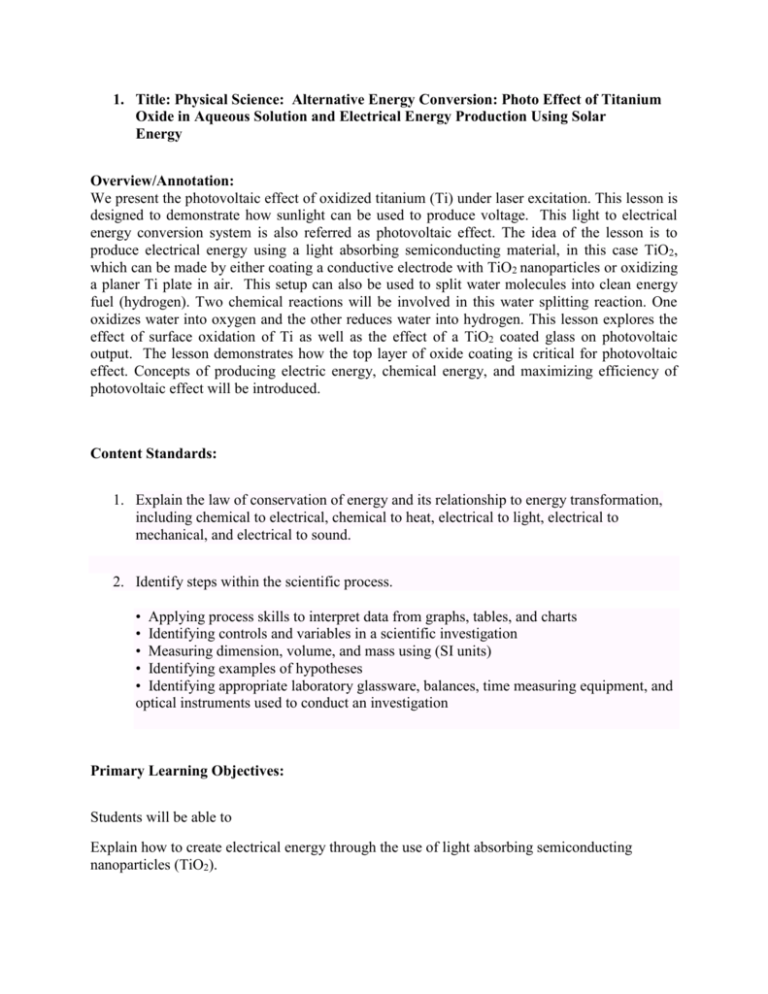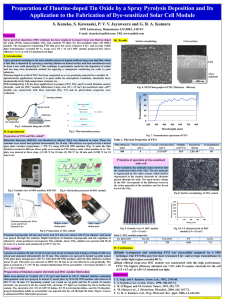Photo Effect of Titanium Oxide in Aqueous Solution and Electrical
advertisement

1. Title: Physical Science: Alternative Energy Conversion: Photo Effect of Titanium Oxide in Aqueous Solution and Electrical Energy Production Using Solar Energy Overview/Annotation: We present the photovoltaic effect of oxidized titanium (Ti) under laser excitation. This lesson is designed to demonstrate how sunlight can be used to produce voltage. This light to electrical energy conversion system is also referred as photovoltaic effect. The idea of the lesson is to produce electrical energy using a light absorbing semiconducting material, in this case TiO2, which can be made by either coating a conductive electrode with TiO2 nanoparticles or oxidizing a planer Ti plate in air. This setup can also be used to split water molecules into clean energy fuel (hydrogen). Two chemical reactions will be involved in this water splitting reaction. One oxidizes water into oxygen and the other reduces water into hydrogen. This lesson explores the effect of surface oxidation of Ti as well as the effect of a TiO2 coated glass on photovoltaic output. The lesson demonstrates how the top layer of oxide coating is critical for photovoltaic effect. Concepts of producing electric energy, chemical energy, and maximizing efficiency of photovoltaic effect will be introduced. Content Standards: 1. Explain the law of conservation of energy and its relationship to energy transformation, including chemical to electrical, chemical to heat, electrical to light, electrical to mechanical, and electrical to sound. 2. Identify steps within the scientific process. • Applying process skills to interpret data from graphs, tables, and charts • Identifying controls and variables in a scientific investigation • Measuring dimension, volume, and mass using (SI units) • Identifying examples of hypotheses • Identifying appropriate laboratory glassware, balances, time measuring equipment, and optical instruments used to conduct an investigation Primary Learning Objectives: Students will be able to Explain how to create electrical energy through the use of light absorbing semiconducting nanoparticles (TiO2). Identify roles of materials in the energy conversion set up (e.g. baking soda, voltage, blue laser, ultraviolet radiation, titanium dioxide). Describe the energy conversion that occurs in the process (e.g. chemical to electrical). Total Duration: 60-90 minutes Materials and Equipment: a) b) c) d) e) f) g) h) i) j) k) l) m) n) o) handheld blue and red lasers multimeter 100 ml beakers 2 electrical wires with alligator clips 1 roll masking or scotch tape 2 squares of fluorine-doped tin oxide (FTO) glass (one side is conductive) 1 small piece of Ti ~5% baking soda prepared by dissolving 5 grams of baking soda in 95 ml water 1% TiO2 nanoparticle solution distilled water barbeque lighter tweezers gloves 1 small paint brush 1 black marker Procedures/Activities: Engage The instructor should ask students to generate a list of the forms of energy. This might include kinetic energy of a running car, electrical energy, light, energy stored in coal and fuel and potential energy. Then ask students how one energy form can be converted to another form. Examples are converting chemical energy in fuel into electrical energy using fuel cell, generating light from electrical energy via a light bulb, and burning coal into water and CO2 by producing heating energy. The instructor then asks “What if the world runs out of gasoline and coal, where do we get energy to power the heating and cooling of our houses, for cooking foods, and running our school buses and other devices like portable electronics and motors. Explore: 1. The instructor provided two pieces of FTO glass. Only one side of the FTO glass is conductive. Use the two probes of the handhold multimeter to test which side of the FTO glass is conductive. Turn on the multimeter and set it to “resistivity mode” for testing conductivity of the glass. There is a piezo buzzer which beeps if the surface is conductive. The conductive side should have low resistivity while the other side of the 2. 3. 4. 5. 6. 7. 8. glass is insulating. Mark the conductive sides of the FTO glasses using the provided marker at its corner. Hold one piece of FTO glass at its corner using a tweezer. Dip a paintbrush into TiO2 solution, and then spread a thin layer of TiO2 onto the conductive side of the FTO glass. Avoid coating the edge of the FTO glass in order to keep its conductive for electrical contact later. Dry the TiO2 layer using a BBQ lighter by heating the nonconductive side of the FTO glass or place the glass painted side up on a pan heated with a hot plate. Don’t touch the FTO using your fingers while heating with the BBQ lighter to avoid possible skin burning. Using the BBQ lighter in a fume hood to avoid fire in open space. It is recommended the teachers use a hotplate to dry the sample. Record the color of the FTO conductive side before and after being coated with TiO2 layer below: Before____________________ After_____________________ Connect one of the two electrical wires to the TiO2 coated FTO glass via its alligator clip. Make sure you will only clip at the exposed FTO edge not on the TiO2 layer to ensure good electrical contact with the FTO glass. Connect the second electrical wires to the second piece of FTO glass (uncoated with TiO2). The contact should be made at its edge. Attach the two pieces of FTO glass to the interior wall a 100 mL baker. Make sure the top and bottom of the FTO glasses are roughly at the same level while the contact edges with the alligator clips are placed on top. The bottom of the two FTO glass should be very close to the bottom of the beaker. The two conductive sides should face each other in parallel. Make sure the two wires and FTO glasses are held in place by tape. Fill the beaker with 5% (by weight) baking soda solution until the top of the solution reaches about 1-2 mm away from the alligator clips of the two electrical wires. Do not let the alligator clips touch the baking soda solution! This can prevent corrosion of the alligator clips and also reduce background current or voltage. This ensures the measured electrical signal later comes only from the FTO and TiO2. Connect the other ends of the two electrical wires to the handheld multimeter. Set the multimeter to “voltage measurement” mode. The difference scale of the voltage mode shows different sensitivity. Small scale measures small voltage. Wait about 1 min to ensure the voltage output of the multimeter establishes stability. Use the blue laser to illuminate the surface of the TiO2 side of the coated FTO electrode which is immersed in baking soda solution and record the response of the voltage output of the multimeter below: Voltage increase or decrease under laser excitation? ____________________ How much voltage changes? __________________ Do you see any voltage change as you illuminate the uncoated FTO electrode? _________________ Using one bare Ti plate available in the module kit package. Hold the other one of Ti plate with tweezer at its corner, and then heat with flame from a BBQ lighter to oxide one side of its surface for about 1 min. It is recommended that the teacher prepare these in advance. Record the color of the oxidized Ti surface_________________ Wait until the heated Ti substrate is cold to room temperature, then wipe off the oxidized side of the Ti plate using tissue to exposure the bottom oxidized layer. Record the color of the oxidized Ti plate below 9. Replace the TiO2 coated FTO glass with the oxidized Ti plate and place in parallel with the uncoated FTO glass with the oxidized side facing the FTO glass. Illuminate the oxidized Ti surface with the blue laser, record the voltage response below: Voltage increase or decrease under laser excitation? ____________________ How much voltage changes?__________________ Do you see any voltage change as you illuminate the uncoated FTO electrode?_________________ Explain Using questions from the explore, probe students’ evidence for determining the differences in the three different squares of glass. Discuss and compare the similarities and differences in the test tubes B and C. Then provide the background to assist students in understanding the differences they find. The solar spectrum from sunlight has a broad spectral range from UV to visible and near infrared, TiO2 can only absorb a small fraction of solar energy in the ultraviolet range. Nanostructured materials provide higher surface area than planer materials to interact with chemicals to make their interactions more efficient. To enhance the efficiency of solar energy conversion, one needs to optimize the nature of nanomaterials to absorb a broad range of solar radiation. A notable aspect of TiO2 system is that electrons move to its surface under sunlight. They are separated from positively charged particles (or holes) under light. The electrons hold a negative potential while holes hold positive potentials. The difference of these potentials can be measured using a voltmeter. Electrons can also reduced chemicals such as in the proton reduction reaction 2H+ + 2e- H2 and holes can oxidized water such as in an oxygen evolution reaction OH- -4e- O2 + H2O. Baking soda is an electrolyte that provides conductivity of the solution by providing sodium (Na+) ions and HCO3- ions. HCO3- can also be protonated to form H2CO3 and OH- to make the solution basic. Abundance of OH- ions would enhance oxygen evolution reaction. TiO2 is a catalytic semiconductor material that can be used for solar water splitting under UV light irradiation. Optimal photoactivity can be achieved when its crystalline structure is in anatase phase which simply refers to a special packing of the atoms. TiO2 nanoparticle solution in this lesson has 75% anatase crystalline phase while the oxidized Ti plate with BBQ lighter does not have much anatase phase Assessment Strategies: 1. What’s the function of baking soda solution? ______________________________________________ 2. Is the oxidation of Ti necessary to obtain photoeffect? Explain using your evidence. _______________________________________________ 3. What does it mean when we see voltage response under light illumination? _______________________________________________ 4. Which one, the paint-brush made TiO2 film or oxidized Ti plate, is more effective generating voltage? Explain _______________________________________________ 5. Why do you think the voltage response is unstable? _______________________________________________ 6. If we use an UV lamp to excite the electrode instead of using a blue laser, what do you think will happen? Why do you think this? ________________________________________________ 7. Regular solar cells have large voltage response under sunlight. Why do you think the voltage response of this module so small? ________________________________________________ 8. What are the chemical reactions involved at the interface of TiO2 plate and baking soda solution? Are they useful reactions? (Hint: baking soda solution is basic solution) _______________________________________________ Extension: Form student teams to explore the following as an extension to contemporary research with energy efficient materials. a. What is a solar cell? b. Is sunlight the best option available to meet the world’s energy challenge? c. In comparison to fossil fuel, describe the benefits of using solar cells? Does solar cell produce CO2? d. What are possible ways to improve the quality of the TiO2 solar cell in this lesson? e. Explain how hydrogen may or may not make an excellent fuel? Explain f. Explain how hydrogen can be produced from water?






